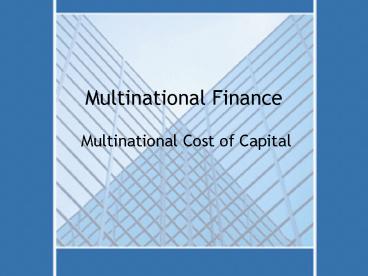Multinational Finance - PowerPoint PPT Presentation
1 / 20
Title:
Multinational Finance
Description:
The risk-free rate may vary across countries. The risk premium may vary across countries. ... MNC's credit risk. MNC's access to earnings. Debt guarantees by ... – PowerPoint PPT presentation
Number of Views:22
Avg rating:3.0/5.0
Title: Multinational Finance
1
Multinational Finance
- Multinational Cost of Capital
2
Outline
- Objectives
- Cost of Capital
- Cost of Debt
- Cost of Equity
3
Objectives
- To explain how corporate and country
characteristics influence an MNCs cost of
capital. - To explain why there are differences in the costs
of capital across countries. - To explain how corporate and country
characteristics are considered by an MNC when it
establishes its capital structure.
4
Cost of Capital
- A firms capital consists of equity (retained
earnings and funds obtained by issuing stock) and
debt (borrowed funds). - The cost of equity reflects an opportunity cost,
while the cost of debt is reflected in interest
expenses. - Firms want a capital structure that will minimize
their cost of capital, and hence the required
rate of return on projects.
5
Cost of Capital Formula
- A firms weighted average cost of capital
- kc ( D ) kd ( 1 _ t ) ( E )
ke - D E
D E - D is the amount of debt of the firm
- E is the equity of the firm
- kd is the before-tax cost of its debt
- t is the corporate tax rate
- ke is the cost of financing with equity
6
Background on Cost of Capital
- A firms capital consists of equity (retained
earnings and funds obtained by issuing stock) and
debt (borrowed funds). - There is an advantage to using debt rather than
equity as capital because the interest payments
on debt are tax deductible.
7
Background on Cost of Capital
- The interest payments on debt are tax deductible.
However, as interest expenses increase, the
probability of bankruptcy will increase too. - It is favorable to increase the use of debt
financing until the point at which the bankruptcy
probability becomes large enough to offset the
tax advantage of using debt.
8
Cost of Capital for MNCs versus Domestic Firms
- The cost of capital for MNCs may differ from that
for domestic firms because of the following
differences. - 1. Size of Firm.
- 2. Access to International Capital Markets.
- 3. International Diversification.
- 4. Exposure to Exchange Rate Risk.
- 5. Exposure to Country Risk.
9
Costs of Capital Across Countries
- The cost of capital may vary across countries
because of these factors - The cost of debt may vary across countries.
- The risk-free rate may vary across countries.
- The risk premium may vary across countries.
- The cost of equity may vary across countries.
- Opportunity costs
10
Cost of Equity
- To assess how required rates of return of MNCs
differ from those of purely domestic firms, the
CAPM can be applied. - The CAPM suggests that the required return on a
firms stock is a positive function of (1)the
risk-free rate of interest,(2)the market rate of
return and (3)the stocks beta - The beta represents the sensitivity of the
stocks returns to market returns
11
Cost of Equity
- The capital asset pricing model (CAPM) can be
used to assess how the required rates of return
of MNCs differ from those of purely domestic
firms. - According to CAPM, ke Rf b(Rm Rf )
- ke the required return on a stock
- Rf risk-free rate of return
- Rm market return
- b the beta of the stock
12
Cost of Equity
- Unsystematic risks vs. systematic risks.
- Capital asset pricing theory would suggest that
the MNC cost of capital is generally lower than
that of domestic firms. - Since markets are becoming most integrated over
time, one could argue that a world market is more
appropriate than a U.S. market for US-based MNCs. - MNCs may attempt to take full advantage of the
favorable aspects that reduce its cost of
capital.
13
The MNCs Capital Structure Decision
- The overall capital structure of an MNC is
essentially a combination of the capital
structures of the parent body and its
subsidiaries. - The capital structure decision involves the
choice of debt versus equity financing, and is
influenced by both corporate and country
characteristics.
14
The MNCs Capital Structure Decision
- Influence of corporate concerns
- Stability of MNCs cash flows / profitability
- MNCs credit risk
- MNCs access to earnings
- Debt guarantees by parent
- Agency problems
15
The MNCs Capital Structure Decision
- Influence of country concerns
- Interest rates
- Investment opportunities
- F/X concerns
- Country risk
- Tax laws
16
The MNCs Capital Structure Decision
- When they exhibit such corporate characteristics
as predictable cash flows, low credit risk, and
limited access to retained earnings, an MNC may
prefer to use a greater percentage of debt in its
capital structure.
17
The MNCs Capital Structure Decision
- When they are subject to such international
concerns as a high degree of country risk, weak
local currencies, high taxes and low interest
rates, an MNC may prefer to use a greater
percentage of debt in its capital structure.
18
Conclusion
- Introduction to the Cost of Capital
- Comparing the Costs of Equity and Debt
- Cost of Capital for MNCs
- Size of Firm
- Access to International Capital Markets
- International Diversification
- Exposure to Exchange Rate Risk
- Exposure to Country Risk
19
Conclusion
- Cost of Capital for MNCs continued
- Cost of Capital Comparison Using the CAPM
- Implications of the CAPM for an MNCs Risk
- Costs of Capital Across Countries
- Using the Cost of Capital for Assessing Foreign
Projects - The MNCs Capital Structure Decision
20
Problems
- Lets try a few problems!































